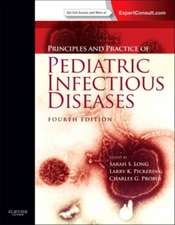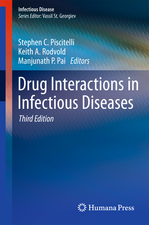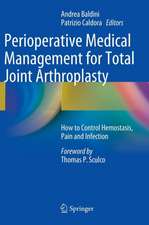Antimicrobial Resistance in Developing Countries
Editat de Aníbal de J. Sosa, Denis K. Byarugaba, Carlos F. Amábile-Cuevas, Po-Ren Hsueh, Samuel Kariuki, Iruka N. Okekeen Limba Engleză Hardback – 20 oct 2009
| Toate formatele și edițiile | Preț | Express |
|---|---|---|
| Paperback (1) | 957.94 lei 6-8 săpt. | |
| Springer – 2 sep 2014 | 957.94 lei 6-8 săpt. | |
| Hardback (1) | 964.23 lei 6-8 săpt. | |
| Springer – 20 oct 2009 | 964.23 lei 6-8 săpt. |
Preț: 964.23 lei
Preț vechi: 1175.88 lei
-18% Nou
Puncte Express: 1446
Preț estimativ în valută:
184.53€ • 200.37$ • 155.00£
184.53€ • 200.37$ • 155.00£
Carte tipărită la comandă
Livrare economică 23 aprilie-07 mai
Preluare comenzi: 021 569.72.76
Specificații
ISBN-13: 9780387893693
ISBN-10: 0387893695
Pagini: 554
Ilustrații: XXIII, 554 p.
Dimensiuni: 155 x 235 x 32 mm
Greutate: 0.98 kg
Ediția:2010
Editura: Springer
Colecția Springer
Locul publicării:New York, NY, United States
ISBN-10: 0387893695
Pagini: 554
Ilustrații: XXIII, 554 p.
Dimensiuni: 155 x 235 x 32 mm
Greutate: 0.98 kg
Ediția:2010
Editura: Springer
Colecția Springer
Locul publicării:New York, NY, United States
Public țintă
ResearchDescriere
Avoiding infection has always been expensive. Some human populations escaped tropical infections by migrating into cold climates but then had to procure fuel, warm clothing, durable housing, and crops from a short growing season. Waterborne infections were averted by owning your own well or supporting a community reservoir. Everyone got vaccines in rich countries, while people in others got them later if at all. Antimicrobial agents seemed at first to be an exception. They did not need to be delivered through a cold chain and to everyone, as vaccines did. They had to be given only to infected patients and often then as relatively cheap injectables or pills off a shelf for only a few days to get astonishing cures. Antimicrobials not only were better than most other innovations but also reached more of the world’s people sooner. The problem appeared later. After each new antimicrobial became widely used, genes expressing resistance to it began to emerge and spread through bacterial populations. Patients infected with bacteria expressing such resistance genes then failed treatment and remained infected or died. Growing resistance to antimicrobial agents began to take away more and more of the cures that the agents had brought.
Cuprins
Section I: General Issues in Antimicrobial Resistance. Global perspectives of the Resistance Problem.- Mechanisms of Resistance.- Poverty and Root Causes of Resistance in Developing Countries.- What the Future Holds for Resistance in Developing Countries.- The Introduction of Antimicrobial Agents in Poor-resource Countries: Impact on the Emergence of Resistance.-Section II: The Human Impact of Resistance. HIV Resistance in Developing Countries.- Drug Resistance in Malaria in Developing Countries.- Drug Resistance in Tuberculosis in Developing Countries.- Antifungal Drug Resistance in Developing Countries.- Antimicrobial Resistance in African Trypanosomiasis.- Resistance in Enteric Pathogens in Developing Countries.-Bacterial Resistant Infections in Resource-Limited Countries.- Prevalence of Resistant Enterococci in Developing Countries.- Antimicrobial Resistance in Gram-negative Bacteria from Developing Countries.- Resistance in Reservoirs and Human Commensals.-Section III: Antimicrobial Use and Misuse. Determinants of Antimicrobial Use: Poorly Understood - Poorly Researched.- Antimicrobial Use and Antimicrobial Resistance in African Countries.- Antimicrobial Use and Antimicrobial Resistance in Asian Countries.- Antimicrobial Use and Antimicrobial Resistance in Latin America and the Caribbean Countries.- Hospital Infections by Antimicrobial Resistant Organisms in Developing Countries.-Section IV: Cost, Policy and Regulation of Antimicrobials. Economic Burden of Antimicrobial Resistance.- Health Systems Strengthening to Improve Access to Antimicrobials and the Containment of Resistance.- The Role of Unregulated Sale and Dispensing of Antimicrobial Agents on the Development of Antimicrobial Resistance in Developing Countries.- Counterfeit and Substandard Anti-Infectives in Developing Countries.-Section V: Strategies to contain AMR. Containment of Antimicrobial Resistance in Developing Countries & Lessons Learned.- Surveillance of Antimicrobial Resistance.- Vaccines: A Cost-effective Strategy to Contain Antimicrobial Resistance.- Teaching Antibiotic Prescription Practices in Medical Schools in Developing Countries.- Containing Global Antibiotic Resistance: Ethical Drug Promotion in the Developing World.- News Media Reporting of Antimicrobial Resistance in Latin America and India.
Recenzii
Aus den Rezensionen:“... In dem Buch werden von insgesamt 30 Autorinnen (Mikrobiologen und Infektiologen) in hervorragenden Übersichtsartikeln all die genannten Probleme dargestellt. Die Literaturangaben sind auf dem neuesten Stand. Für alle die sich mit Infektionserkränkungen hier und in armen Ländern beschäftigen ist das Buch ein Muss und kann uneingeschränkt empfohlen werden.“ (Dr Gerhard Schwarzkopf-Steinhäuser, in: Pharma-Brief, May/June/2010, Issue 4-5, S. 4 f.)
Textul de pe ultima copertă
"Antimicrobial Resistance in Developing Countries, edited by Drs. Anibal Sosa and Denis Byarugaba, and their associate editors is unique in focusing on antimicrobial resistance as it relates to, and threatens developing countries. It is curious that it has taken this long to produce a book dedicated to antibiotic resistance in this part of the world. One can ask "why?", since resistance is and has been so common there. In fact, whereas resistance has been addressed for the past four decades by experts in the industrialized world, studies describing the problem and the public health situation in the developing world have lagged behind. Although we have learned much from studies of the genetics and molecular biology of the problem from investigations in industrialized countries, it is in developing countries where more studies and efforts are needed. With travel encouraging the transport of microbes, the information in this book will have wide sweeping benefit, not only for developing countries, but also for the world at large. Surveillance of resistance and the prevention of resistance need attention on a worldwide basis. Improving antibiotic use requires a global effort".
Prof. Stuart B. Levy
Tufts University School of Medicine
The Alliance for Prudent Use of Antibiotics Boston, MA
Prof. Stuart B. Levy
Tufts University School of Medicine
The Alliance for Prudent Use of Antibiotics Boston, MA
Caracteristici
Provides information about the problem of antimicrobial resistance in developing countries addressing the general global perspectives, the risk factors, the current rates, trends, and possibilities for containment as they relate to specific conditions in those countries
Includes supplementary material: sn.pub/extras
Includes supplementary material: sn.pub/extras










